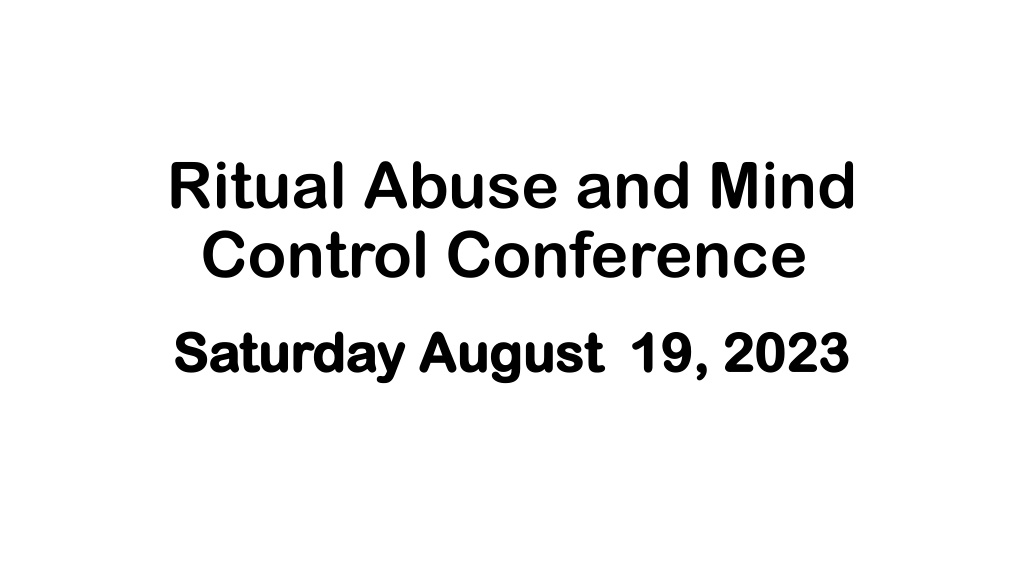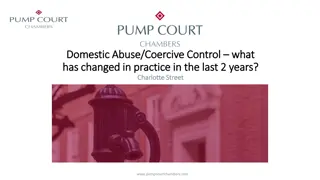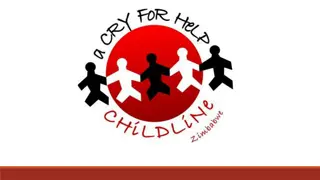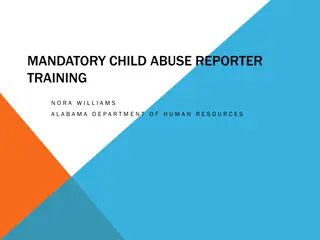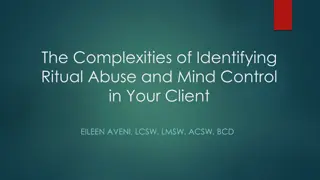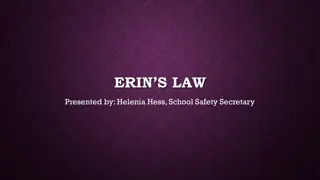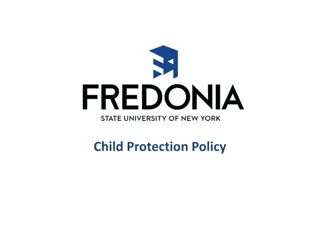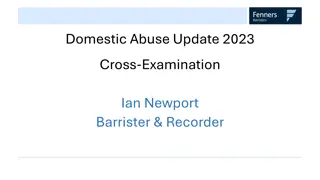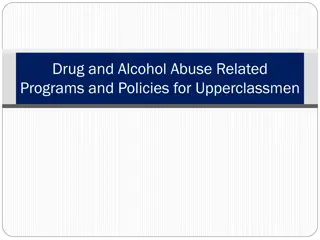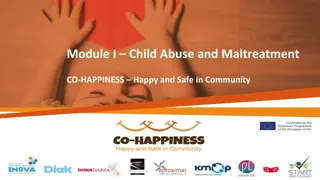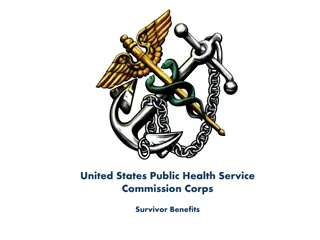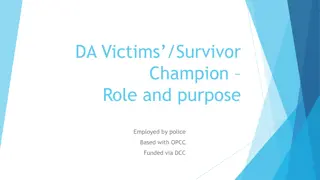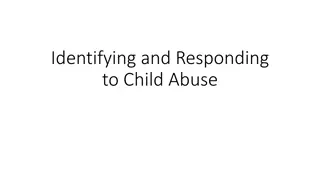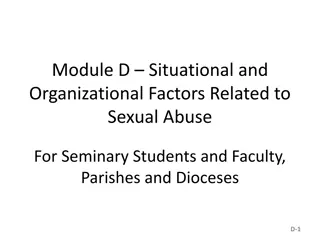Ritual Abuse and Survivor Support: A Historical Perspective
Explore the history of ritual abuse and its effects on survivors through the lens of social movements. Learn from Neil Brick's insights on survivor support systems and recovery. Delve into key periods in the history of child and ritualistic abuse, shedding light on the brutal nature of these crimes and the importance of awareness and support. Be cautious, as this presentation may trigger memories in survivors.
Download Presentation

Please find below an Image/Link to download the presentation.
The content on the website is provided AS IS for your information and personal use only. It may not be sold, licensed, or shared on other websites without obtaining consent from the author. Download presentation by click this link. If you encounter any issues during the download, it is possible that the publisher has removed the file from their server.
E N D
Presentation Transcript
Ritual Abuse and Mind Control Conference Saturday August 19, 2023 Saturday August 19, 2023
The Effects of Social Movements on Survivor Support Systems and Survivor Recovery Neil Brick will speak about the history of ritual abuse and the effects of social movements on survivors. He will present historical information regarding the literature of clinicians and researchers. He will describe the effects of social and historical movements on survivor support systems and survivor recovery.
Neil Brick Neil Brick is a survivor of ritualistic abuse. His work continues to educate the public about child abuse, trauma and ritualistic abuse crimes. His child abuse and ritualistic abuse newsletter S.M.A.R.T. https://ritualabuse.us has been published for over 28 years. http://neilbrick.com
Please note: This presentation may remind survivors of their programming. Please use caution while reading this. Please use your support systems, grounding techniques or take breaks as needed.
This presentation will focus on different periods in the history of child and ritualistic abuse. Ritual abuse has been defined as: a brutal form of abuse of children, adolescents, and adults, consisting of physical, sexual, and psychological abuse, and involving the use of rituals. (Report of the Ritual Abuse Task Force - Los Angeles County Commission for Women http://ritualabuse.us/ritualabuse/articles/report-of-the- ritual-abuse-task-force-los-angeles-county-commission-for- women/ )
1890 - 1930 Between 1880 and 1920, many great international medical conferences devoted a lot of time to sessions on dissociation. (Putnam - Diagnosis and Treatment of Multiple Personality Disorder) Pierre Janet (1859 - 1947) stands first among all clinicians and researchers who have inquired into the nature of dissociation. (Putnam p.2). He followed the ideas of Jean-Martin Charcot who was re-establishing hypnosis as a focus of scientific inquiry. In 1889 he began his medical studies. He studied patients with amnesias, fugues, successive existences (alter personalities) and conversion symptoms postulating these symptoms were attributed to the existence of the personalities split off parts. He showed how dissociated elements caused one s symptoms or behaviors had their origins in past traumas. They could be treated by bringing the split-off memories and affects into consciousness. (Putnam)
Janet Contemporaries of Janet in North America discussed similar concepts. Boris Sidis discussed the question of suggestibility. He believed that in each person there were two streams of consciousness making two separate selves, a waking self and subwaking self (lacking morality and willing to carry out any act. Other wrote about patients containing two or more systems or different selves. (Putnam) Janet noticed significant differences between ordinary and traumatic memory. Traumatic memories were caused by triggers. He coined the word dissociation to describe the splitting and isolating of memories in his patients. He realized the cost of keeping traumatic memories dissociated, which was a decrease in functioning. The goal of treatment was association, integrating the trauma memories into life. (van der Kolk - The body keeps the score)
Freud Freud in 1893 wrote about how traumatized people have a total loss of memory. The treatment was later called the talking cure. Hysterical symptoms disappeared when the memory of the event which caused it was discussed with its accompanying affect. In 1896 he wrote the ultimate cause of hysteria is always the seduction of the child by an adult. When Freud was confronted with his own evidence of abuse in the best families in Vienna, which implicated his own father, he retreated. Psychoanalysis moved to emphasize unconscious wishes and fantasies. After WWI, Freud reaffirmed that a lack verbal memory of trauma will cause the person continue acting out the trauma. (van der Kolk)
Dissociation, MPD Schizophrenia misdiagnosis In the 1930's there was a decline in interest in the concept of dissociation. There was a conflict between the dissociative and psychoanalytic models. Janet reported his research findings had been confirmed. The psychoanalysts reported they were not finding cases of multiple personality by clinicians using hypnosis, stating these alter personalities were induced hypnotically by therapists. Dissociation continued to be identified in the 1930's, including psychogenic loss of identity and amnesia. Repression was considered responsible for the banishment of ideas and memories from conscious awareness. Amnesia was thought to be the result of the repressive process protecting the person from unpleasant affects. (Putnam) Starting in about 1927, there was a large increase in the number of reported cases of schizophrenia, which was matched by an equally large decrease in the number of multiple personality reports.[18] Bleuler also included multiple personality in his category of schizophrenia. It was found in the 1980s that MPD patients are often misdiagnosed as suffering from schizophrenia.[18] Multiple personality disorder began to emerge as a separate disorder in the 1970s when an initially small number of clinicians worked to re-establish MPD as a legitimate diagnosis. (Putnam)
Political Climates and Social Trends By the end of the 19thcentury All the major nations (except Spain....) had parliaments and a multiparty system, and most had granted universal manhood suffrage. Socialism, including trade union development was occurring in various parts of Europe. Universal public schooling was increasing by the end of the century. Welfare and social insurance programs were being developed. (Britannica History of Europe) By the end of the 19thcentury All the major nations (except Spain....) had parliaments and a multiparty system, and most had granted universal manhood suffrage. Socialism, including trade union development was occurring in various parts of Europe. Universal public schooling was increasing by the end of the century. Welfare and social insurance programs were being developed. (Britannica)
The New Century ....In England, the Fabians, of whom Shaw was one, were preaching the inevitableness of gradualism toward the socialist state. It was they, seconded by the growing strength of the trade unions after a spectacular dock strike of 1889, who paved the way to Labour governments and the British welfare state. Throughout Europe, socialism was no longer the creed of a lunatic fringe but was the ideal of many among the masses and the intellectuals. The original fight for liberty and democracy in political action had turned into a fight for economic democracy freedom from want. Laissez-faire liberalism had turned inside out, and the liberal imagination at work in the many brands of socialism now demanded state interference to remove the appalling conditions causing all the despair. ....Nor did action wait until all the books were out. From the onset of the overturn, say 1885 onward, the rebellion was a biographical fact. Individuals braved public opinion and got divorced, lived together unmarried, practiced and preached contraception, studied the psychology of sex, and defended homosexuality. Or again, the sons of the rich turned socialist, became labour leaders, and fomented syndicalist (i.e., direct-action) strikes, while the daughters demanded the vote as suffragists, assaulted policemen, and went to jail for chaining themselves to the door handles of government offices. Meanwhile, students rioted about international incidents or university affairs; schools were subjected to the devastation of the softer pedagogies; rational clothing exhibited itself in spite of derision, like the bicycle and the newfangled automobile; and new cults multiplied like mushrooms outdoor sports, nudism. (Britannica)
Effects of Social Movements on Survivor Support Systems Progressive movements in history have often led to progressive changes in clinical techniques, techniques that are more client centered and empathetic to client trauma histories. The era around the turn of the 19th century saw the development of progressive political movements, which in turn led to the increased freedom of thought in the field of psychology. This freedom allowed clinicians to look at trauma and its symptoms and ways to treat trauma successfully. (Britannica) This era after WWI saw the growth of Fascism, brainwashing and propaganda techniques. This led to the development of negative forms of psychotherapeutic treatment which caused poor client treatment..
1930 1970 There was a transition period in social trends and world politics after World War I. The period since 1914 in Europe has been marked by major economic and political upheavals. The most cataclysmic were the two world wars. The second of these resulted from the rise of dictatorship in Italy and Germany; but the period also saw dictatorships in Spain and Portugal, as well as in the U.S.S.R., where the 1917 revolution was followed by the totalitarian rule of Joseph Stalin. (Britannica) This era saw the growth of Fascism and brainwashing and propaganda techniques.
1930 1930 - - 1970 1970 Nazism, Fascism, brainwashing, growth of propaganda The political climate and social trends influenced the ways trauma survivors were treated in therapy and psychiatric hospitals. This transition period led to the increase in non-client centered techniques. Trauma stories were often ignored. Bleuler included multiple personality in his category of schizophrenia. The Dark Ages of Psychiatry developed. Some of these techniques would be considered torture today. There was an emphasis on over medicating clients against their will. To be clear, some progressive techniques also developed during this period (Carl Rogers, etc.)
1930-1950: New Treatments Conversative social movements led to the development of nonclient centered treatment modalities, at times forcing client into treatment against their will. At times, the research for these treatments was paid for by government agencies. Electroshock Therapy The use of certain treatments for mental illness changed with every medical advance. Although hydrotherapy, metrazol convulsion, and insulin shock therapy were popular in the 1930s, these methods gave way to psychotherapy in the 1940s. By the 1950s, doctors favored artificial fever therapy and electroshock therapy. Hydrotherapy was used where patients would be put in very cold or very hot water. These techniques were used to decrease client symptoms, often in locked institutional settings.
1930 1966 Surgical Treatment In the 1930s, Portuguese neurologist Egas Monitz pioneered the lobotomy--a procedure in which the brain's frontal lobe nerves are .Widely accepted as a treatment for mental illness through the 1950s, the process attempted to control various behaviors by altering the section of the brain affecting social conduct. At Fulton, the philosophy of treating mental illness aggressively sometimes meant lobotomy. The hospital performed its last lobotomy in 1966; psychiatric drugs made the method obsolete. (1930 1966 Surgical Treatment)
William Sargant - Battle for the Mind Battle for the Mind: A Physiology of Conversion and Brainwashing - How Evangelists, Psychiatrists, Politicians, and Medicine Men Can Change Your Beliefs and Behavior (1957) William Sargant first looked at combat PTSD and compared it to Pavlov s classical conditioning. He extended Pavlov s model to explain how people could change their world view suddenly. This was caused by intense trauma, followed by a person s personality breaking down, followed by the application of new ways of thinking. Pavlov s dogs during a flood either forgot or reversed their previous training. First, Pavlov s equivalent phase of brain activity or breakdown occurred. Second, Pavlov s paradoxical inhibition occurred where weak stimuli would produce strong responses and strong stimuli would produce weak responses (inappropriate responses). Third, in the ultraparadoxical stage, responses changed from positive to negative and vice-versa. Certain models of PTSD suggest that PTSD can be understood as learned helplessness, a set of foci in the brain firing repeatedly and inappropriately. Cognitively, a person s world view is so changed as to become untenable. Pavlov s observations on animals breaking down under extreme stress could be applied to humans and survivors.
Pavlov Pavlov was able to build up and break down behavior patterns in dogs. Pavlov s work seems to have influenced confession getting and brainwashing techniques. Pavlov s dogs had four basic temperaments, strong excitatory, lively, calm imperturbable type and melancholic. Each type reacted differently to stress. Pavlov could cause a dog to break down by increasing the intensity of a signal (electricity), delaying the time between the signal and food, confusing them with positive and negative signals interchanged or tampering with its physical condition. If a dog of stable temperament acquires a behavior after extreme stress, it is hard to break this behavior. (Sargant) This could be compared to a person of strong character becoming a one- track minded fanatic. Some survivors may also become fanatics. The implications for survivors of ritual abuse and their symptoms are obvious. Increased trauma could cause dissociation, making a person more susceptible to suggestion. The delay of gratification could also make one more suggestible. Positive and negative signals interchanged, like praise and insults given rapidly can cause a break. Or the lack of sleep, food or drugging can also make one more suggestible. And once a survivor becomes suggestible, they are easier to program or reprogram. (How Cues and Programming Work in Mind Control and Propaganda)
Sargants work applied According to Sargant, various types of beliefs can be implanted in people after brain functioning has been disturbed by fear, anger or excitement. These cause heightened suggestibility and impaired judgement. These group manifestations may be classified as the herd instinct, they appear most strongly in wartime and periods of common danger. Prolonging the time between giving a signal and the reward or giving an unexpected shock or alternating positive and negative signals and not giving the reward can also cause dramatic changes in patterns of behavior. In brain-washing and eliciting confessions an induced sense of guilt is important to achieve. This is also common when programming survivors. Anger against external and internal enemies nationally can be used to make the masses suggestible, like hatred of those that are different or fighting wars with other countries. Examples in our media today are all too obvious. It is unfortunately too easy to direct people s attention away from the fraudulent elections in our country and the outright thievery of the rich corporations against the populace, by creating enemies and fear. (How Cues and Programming Work in Mind Control and Propaganda)
Dr. Ewen Cameron President of the American Psychiatric Association (1952 1953), Canadian Psychiatric Association (1958 1959), American Psychopathological Association (1963), Society of Biological Psychiatry (1965) and the World Psychiatric Association (1961 1966). Today, many journalists, doctors, and the general public see the Allan Memorial Institute in Royal Victoria Hospital as the cradle of modern torture, a cradle built and rocked by Scottish-born Dr. Donald Ewen Cameron. To the patients of Dr. Ewen Cameron, our university was the site of months of seemingly unending torture disguised as medical experimentation an experimentation that destroyed their lives and changed the course of psychological torture forever. Cameron s experiments, known as MK-ULTRA subproject 68, were partially funded by the CIA and the Canadian government, and are widely known for their use of LSD, barbiturates, and amphetamines on patients. In the media, they were known as the mind control studies done at McGill and were reported as a brainwashing conspiracy from the CIA and the Canadian government . (MK-ULTRA Violence)
Cameron and MK-ULTRA Cameron s experiments, known as MK-ULTRA subproject 68, were partially funded by the CIA and the Canadian government, and are widely known for their use of LSD, barbiturates, and amphetamines on patients. In the media, they were known as the mind control studies done at McGill and were reported as a brainwashing conspiracy from the CIA and the Canadian government .
Cameron, Hebb and MK-ULTRA Dr. Hebb paid a group of his own psychology students to remain isolated in a room, deprived of all senses, for an entire day. In an attempt to determine a link between sensory deprivation and the vulnerability of cognitive ability, Hebb also played recordings of voices expressing creationist or generally anti-scientific sentiments clearly, ideas psychology students would oppose. However, the prolonged period of sensory deprivation made the students overly susceptible to sensory stimulation. Students suddenly became very tolerant of the ideas that they had readily dismissed before. MK-ULTRA Subproject 68 Cameron s research was based on the ideas of re-patterning and re-mothering the human mind. He believed that mental illness was a consequence of an individual having learned incorrect ways of responding to the world. These learned responses created brain pathways that led to repetitive abnormal behaviour. (MK-ULTRA Violence)
De-patterning treatment Dr. Cameron wanted to de-pattern patients minds with the application of highly disruptive electroshock twice a day, as opposed to the norm of three times a week. According to him, this would break all incorrect brain pathways, thus de- patterning the mind. Some call it brainwashing; Cameron called it re-patterning . Preparation period: prolonged sleep, invasive electroshock, extreme forms of sensory deprivation Following the preparation period and the de-patterning came the process of psychic driving or re-patterning, in which Cameron would play messages on tape recorders to his patients. He alternated negative messages about the patients lives and personalities with positive ones; these messages could be repeated up to half a million times . (MK-ULTRA Violence)
MK-ULTRA and the CIA The experiments done at McGill were part of the larger MK-ULTRA project led by Sidney Gottlieb of the CIA. In 1963, the year in which MK-ULTRA ended, the CIA compiled all the research into a torture manual called the Kubark Counterintelligence Interrogation Handbook. Yes, a torture manual that would eventually define the agency s interrogation methods and training programs throughout the developing world . Only decades later, in the 1980s, did past victims speak about their experiences, and by the nineties, the lawsuits began to pile up. In response, the Canadian government launched The Allan Memorial Institute Depatterned Persons Assistance Plan, which provided $100,000 to each of the former patients of Dr. Ewen Cameron. The compensation came from a recommendation by lawyer George Cooper, in which he clarified that the Canadian government did not have a legal responsibility for what happened, but a moral responsibility. (MK-ULTRA Violence).
Crossover between social movements and therapy We have discussed how social trends may influence survivor treatment in therapy. With MK-ULTRA and the development of brainwashing and torture techniques, we can see how these trends directly influenced therapeutic treatment.
Propaganda Development in the 20thCentury Propaganda propaganda, dissemination of information facts, arguments, rumours, half-truths, or lies to influence public opinion. Propaganda is the more or less systematic effort to manipulate other people s beliefs, attitudes, or actions by means of symbols (words, gestures, banners, monuments, music, clothing, insignia, hairstyles, designs on coins and postage stamps, and so forth). Deliberateness and a relatively heavy emphasis on manipulation distinguish propaganda from casual conversation or the free and easy exchange of ideas. Propagandists have a specified goal or set of goals. To achieve these, they deliberately select facts, arguments, and displays of symbols and present them in ways they think will have the most effect. To maximize effect, they may omit or distort pertinent facts or simply lie, and they may try to divert the attention of the reactors (the people they are trying to sway) from everything but their own propaganda. ....Still another related concept is that of brainwashing. The term usually means intensive political indoctrination. It may involve long political lectures or discussions, long compulsory reading assignments, and so forth, sometimes in conjunction with efforts to reduce the reactor s resistance by exhausting him either physically through torture, overwork, or denial of sleep or psychologically through solitary confinement, threats, emotionally disturbing confrontations with interrogators or defected comrades, humiliation in front of fellow citizens, and the like. (Britannica).
Social Trends in the Modern Era In the 1960s, there were movements around the world, fighting for the rights of women, minorities, people of color, gay people, democracy and freedom of expression. These movements were expressed in music, literature, art and the media. This led to an interest in empowering those that had previously been oppressed. Crimes against children and women began to be discussed in more detail. This led to discussions and research around trauma and its symptoms. A backlash in the United States occurred in the late 1970's and 1980's, where the right wing began to attack and shut down freedoms. This led to a backlash against child abuse survivors and rape victims as well. This backlash continued through the 1990's.
Therapeutic Trends 1970 1990 There was a renewal of interest in dissociation in the 1970s and 1980s. Dissociative psychopathology was seen as an alteration in one s sense of identity, complete amnesia such as psychogenic amnesia or fugue states or a series of alternating identities claiming independence from the others, like MPD. From studying dissociative reactions it was found that The vast majority of dissociative disorders are traumatically induced. (Putnam P. 7) Estimated incidences of wartime dissociative syndromes range from 5 to 14%. There is strong evidence linking the development of MPD to severe, recurrent traumatic experiences usually occurring in during childhood or early adolescence. (Putnam P. 8). Dissociation was seen to be a normal process initially used defensively by a person evolving later into a maladaptive process. The DSM-III (1980) and III-R (1987) recognized psychogenic amnesia, psychogenic fugue, depersonalization disorder and MPD. (Putnam) This research led to the development of new ways to help those suffering from severe trauma. At the same time, a backlash occurred. This is similar in some ways to the backlash that occurred around 1900, when wealthy families were accused of child abuse. This is like the backlash of the 1890's.
Ritualistic Abuse in the 1980s & The Backlash The 1980s showed an increase in the study of ritualistic abuse. Falsely misconstrued now as a panic, whose proponents were often connected to, part of or informed by those accused of or legally defending those accused of crimes. This included organizations like VOCAL (1980s) or the FMSF (1990s). Both groups were founded in part by Ralph Underwager, who later made statements in a Dutch publication like: Paedophiles spend a lot of time and energy defending their choice. I don t think that a paedophile needs to do that. Paedophiles can boldly and courageously affirm what they choose. Well documented and well research books like Michelle Remembers and Sybil were later attacked by those not educated in the field as false. Both stories were verified by researchers of their time and Sybil continued to be verified for many years after. (SMART https:/ritualabuse.us ) The backlash negatively effect resources for survivors. Organizations closed and trauma treatment clinicians were pushed underground.
Ross Cheit Rebutting the Witch Hunt Narrative In the 1980s, a series of child sex abuse cases rocked the United States. The most famous case was the 1984 McMartin preschool case, but there were a number of others as well. By the latter part of the decade, the assumption was widespread that child sex abuse had become a serious problem in America. Yet within a few years, the concern about it died down considerably. The failure to convict anyone in the McMartin case and a widely publicized appellate decision in New Jersey that freed an accused molester had turned the dominant narrative on its head. In the early 1990s, a new narrative with remarkable staying power emerged: the child sex abuse cases were symptomatic of a "moral panic" that had produced a witch hunt. A central claim in this new witch hunt narrative was that the children who testified were not reliable and easily swayed by prosecutorial suggestion. In time, the notion that child sex abuse was a product of sensationalized over-reporting and far less endemic than originally thought became the new common sense. (The Witch-Hunt Narrative: Politics, Psychology, and the Sexual Abuse of Children - Cheit)
Cheit (continued) But did the new witch hunt narrative accurately represent reality? As Ross Cheit demonstrates in his exhaustive account of child sex abuse cases in the past two and a half decades, purveyors of the witch hunt narrative never did the hard work of examining court records in the many cases that reached the courts throughout the nation. Instead, they treated a couple of cases as representative and concluded that the issue was blown far out of proportion. Drawing on years of research into cases in a number of states, Cheit shows that the issue had not been blown out of proportion at all. In fact, child sex abuse convictions were regular occurrences, and the crime occurred far more frequently than conventional wisdom would have us believe. Cheit's aim is not to simply prove the narrative wrong, however. He also shows how a narrative based on empirically thin evidence became a theory with real social force, and how that theory stood at odds with a far more grim reality. The belief that the charge of child sex abuse was typically a hoax also left us unprepared to deal with the far greater scandal of child sex abuse in the Catholic Church, which, incidentally, has served to substantiate Cheit's thesis about the pervasiveness of the problem. In sum, The Witch- Hunt Narrative is a magisterial and empirically powerful account of the social dynamics that led to the denial of widespread human tragedy. (Cheit Amazon)
Cheit References Recovered Memory Project (developed evidence verifying recovery memory in legal cases and rebutting the backlash) - Cheit https://blogs.brown.edu/recoveredmemory/ Cheit, R. E. (2014). The witch-hunt narrative: Politics, psychology, and the sexual abuse of children. (L. A. Krishnaswami, Illustrator). Oxford University Press https://www.amazon.com/Witch-Hunt-Narrative-Politics- Psychology-Children/dp/0190465573
Ralph Underwager Ralph Underwager (28 July 1929 - 29 November 2003) was an American minister and psychologist who rose to prominence as a defense witness for adults accused of child sexual abuse in the 1980s and 1990s. Until his death in 2003, he was the Director of the Institute for Psychological Therapies, which he founded in 1974. He was also a founder of "Victims of Child Abuse Laws" (VOCAL), a lobby group which represented the interests of parents whose children had been removed from their care by social services over abuse allegations, and he was a founding member of the False Memory Syndrome Foundation. Founder of VOCAL Underwager first appeared in court as a defence witness for two of the accused in the 1984 Jordan, Minnesota case, one of the earliest attempts to prosecute organised child sexual abuse in the United States. On the stand, Underwager alleged that the children s testimony of abuse was being coerced by social workers who used Communist thought reform and brainwashing techniques to convince the children they had been abused. The accused couple were acquitted, and they joined with Underwager to form "VOCAL", a lobby group for people who had been accused of child abuse by social services. (Ralph Underwager)
Ralph Underwager Within a year of its establishment, VOCAL claimed 3000 members in 100 chapters across America VOCAL members picketed hospitals, courts and social service departments who remove children solely based on rumours . Throughout the 1980s and 1990s, VOCAL made several attempts to have legislation passed that would limit the powers of child protection services. Nationally, VOCAL campaigned to lift the burden of proof in child protection cases to a criminal standard, which would effectively prevent social services from intervening in cases of child abuse unless a conviction had been obtained in court. (Ralph Underwager)
Ralph Underwager Career as a defense witness Underwager was a prolific defense expert for people accused of child sexual abuse. By the late 1980s, he had appeared in court on behalf of defendants in child sexual abuse cases more than 200 times in the US, Canada, Australia, New Zealand and Britain. In court and in the media, Underwager claimed that 60% of women sexually abused in childhood reported that the experience was good for them. He characterized child protection investigations as nothing less then an assault on the family as an institution In 1994, Underwager received upwards of CAN$18000 in court fees and expenses for a two-day appearance in a Canadian trial. However, as his expert testimony was increasingly rejected by the courts, it emerged that he required all his clients to sign a contract stating that they would pay his legal fees if he was sued for lying on the stand. (Calof, 1994) (Ralph Underwager)
Anna Salter Ralph Underwager Research project by Anna Salter Underwager was the subject of a research project by Dr Anna Salter in 1988, who reviewed the accuracy of his academic writings and the manner in which he presented this testimony in court. She uncovered systematic misrepresentations of research in his writings, as well as outright fabrications, and she concluded that Underwager was a hired gun who makes a living by deceiving judges about the state of medical knowledge and thus assisting child molesters to evade punishment . In response, Underwager filed several unsuccessful suits against Salter, and began a decade-long campaign of intimidation and entrapment including hiring a private detective, fake phone calls that Salter later found had been taped, and threatening letters. [Salter, A. "Confessions of Whistle-Blower: Lessons Learnt", Ethics & Behavior, 8, 2, 1998, 115-124]
Confessions of a Whistle-Blower: Lessons Learned Confessions of a Whistle-Blower: Lessons Learned - Anna C. Salter DOI: Abstract In 1988 I began a report on the accuracy of expert testimony in child sexual abuse cases utilizing Ralph Underwager and Hollida Wakefield as a case study (Wakefield & Underwager, 1988). In response, Underwager and Wakefield began a campaign of harassment and intimidation, which included multiple lawsuits; an ethics charge; phony (and secretly taped) phone calls; and ad hominem attacks, including one that I was laundering federal grant monies. The harassment and intimidation failed as the author refused demands to retract. In addition, the lawsuits and ethics charges were dismissed. Lessons learned from the experience are discussed.
Ralph Underwager Interview controversy Underwager was forced to step down from the advisory board of the False Memory Syndrome Foundation and curtail his public activities after controversy arose over an interview he had given to "Paidika, the Journal of Paedophilia". Interview in Amsterdam in June 1991 by Paidika, Editor-in-Chief, Joseph Geraci. PAIDIKA: Is choosing paedophilia for you a responsible choice for the individuals? RALPH UNDERWAGER: Certainly it is responsible. What I have been struck by as I have come to know more about and understand people who choose paedophilia is that they let themselves be too much defined by other people. That is usually an essentially negative definition. Paedophiles spend a lot of time and energy defending their choice. I don t think that a paedophile needs to do that. Paedophiles can boldly and courageously affirm what they choose. They can say that what they want is to find the best way to love. I am also a theologian and as a theologian, I believe it is God s will that there be closeness and intimacy, unity of the flesh, between people. A paedophile can say: This closeness is possible for me within the choices that I ve made. Paedophiles are too defensive. They go around saying, You people out there are saying that what I choose is bad, that it s no good. You re putting me in prison, you re doing all these terrible things to me. I have to define my love as being in some way or other illicit. What I think is that paedophiles can make the assertion that the pursuit of intimacy and love is what they choose. With boldness, they can say, I believe this is in fact part of God s will. They have the right to make these statements for themselves as personal choices. Now whether or not they can persuade other people they are right is another matter (laughs).
Social Trends and Therapeutic Treatment 1990 - 2000 In the last decade of the 20thcentury, in the United States, after a very conservative political period in the 1980s (Reaganism - breaking unions, increasing the military, etc.) the 1990s were a more moderate period - at least by US standards. However, there was an overlap in terms of the severe repression of trauma treatment philosophies and trauma survivors. This repression of the 1980s by groups like VOCAL and Underwager increased greatly in the 1990s with the Freyds and the FMSF. This included the media promoting erroneous and unproven false memory philosophies. Resources for survivors expanded greatly in the 1980's and 1990's, due to work of those like Bennett Braun and others. In the earlier 1990s this changed when the FMSF developed. The media swung from writing balanced articles on trauma issues to biased ones attacking survivors of trauma.
Bennett Braun Braun s research and influence on the ISSTD at the time was crucial in developing treatment protocols to help survivors of trauma. Braun was repeatedly harassed legally in attempt to silence his research on trauma treatment. Bennett Braun was a famous doctor that worked in the field of dissociation and trauma in the 1980 s and early 1990 s. He created the BASK Model of Dissociation, a model for understanding and healing dissociation that is still used by some today. (Bennett Braun ritualabuse.us )
BASK Model of Dissociation BASK Model of Dissociation The BASK Model of Dissociation Bennett G. Braun, M.D. ABSTRACT The BASK model conceptualizes the complex phenomenology of dissociation along with dimensions of Behavior, Affect, Sensation, and Knowledge. The process of dissociation itself, hypnosis, and the clinical mental disorders that constitute the dissociative disorders are described in terms of this model and illustrated. (Braun The BASK Model) The BASK Model of Dissociation Traces the historical development of the concept of dissociation and presents a contemporary model of the dissociative process, BASK, an acronym representing the dimensions of behavior, affect, sensation, and knowledge. Dissociation is considered as an extreme point on a continuum of awareness that also includes repression, denial, suppression, and full awareness. The BASK model is used to conceptualize normal dissociative processes, such as hypnosis, and to describe dissociative disorders. These include psychogenic amnesia and fugue states, depersonalization, derealization, posttraumatic stress disorder (PTSD), atypical dissociative disorders, and typical and atypical multiple personality disorders. (APA PsycINFO)
Brauns Studies Dissociative states in multiple personality disorder: A quantitative study Our results suggest that simple confabulation is not an adequate model for the MPD syndrome, and we consider a possible role for state-dependent learning in the phenomenology of MPD. Patients reporting ritual abuse in childhood: A clinical syndrome. Thirty-seven adult dissociative disorder patients who reported ritual abuse in childhood by satanic cults are described. Patients came from a variety of separate clinical settings and geographical locations and reported a number of similar abuses. The most frequently reported types of ritual abuse are outlined, and a clinical syndrome is presented. Treatment of Multiple Personality Disorder - Bennett G. Braun
Harassment of Bennett Braun Disciplined doctor licensed in Montana Associated Press October 16, 2003 By Bob Anez After legal attacks in the 1990 s, he agreed to a two-year suspension of his medical license in October 1999 and was given five years probation after accusations by a former patient. Braun had stated that he didn t contest his license suspension and $5,000 fine because he was exhausted financially, emotionally and physically. He said he spent about $500,000 to initially fight the disciplinary case. Candidate accused by former patient by Thomas R. O Donnell Des Moines Register 10/28/98 A former Iowan who won a $10.6 million settlement from a Chicago hospital and two psychiatrists said the diagnosis of multiple personalities and repressed memories of satanic cults that led to her lawsuit originated with a West Des Moines clinical social worker. But the social worker, Ann-Marie Baughman, now a Polk County legislative candidate, said that when she started counseling Patricia Burgus in 1982, Burgus was a troubled woman who was threatening to kill herself and others. Burgus also was displaying behavior that Baughman could not understand. It was the physical changes more than just the verbal expressions of what she was telling me that led Baughman to conclude she was seeing multiple personalities. The muscles in her face would all relax . . . and she would just look different. It was just the eeriest thing .But suggestions that Braun somehow planted the horrific memories in Burgus head are wrong, Baughman said, because they started surfacing during her sessions with Burgus in Des Moines .In the settlement, reached last fall after six years of litigation, neither the hospital nor the psychiatrists, Braun and Elva Poznanski, admitted fault. Braun has said his insurance company settled over his objections.
Burgus v. Braun Here s a summary of the research on Burgus v. Braun et al that was presented by a researcher at the 2002 International Society for the Study of Dissociation conference in Baltimore In 1993 the Burgus family filed a malpractice lawsuit against Rush-Presbyterian-St. Luke s Medical Center, Dr. Elva Poznanski, the boys psychiatrist, and Dr. Bennett Braun, Pat s psychiatrist Before her hospitalization at Rush in 1983, Pat spent most days in bed in with the curtains drawn, unable to care for herself. She threatened to kill herself and others. Her husband came home for lunch to make sure the boys were fed. She became convinced that the doctor who did her tubal ligation had implanted a fetus during the surgery. She approached mothers of infant daughters, asking them if they would trade their daughter for her infant son, Mikey. Pat entered Rush diagnosed with multiple personality disorder and borderline personality disorder. Upon admission Pat was agitated and incoherent. During her first month on the unit and before she was placed on meds, Pat told staff I m switching [personalities] out of control today. I m doing so much switching today I can t believe it. Pat testified that the rapid switching decreased over time as her medications were increased .Other patients said they recognized her from her participation in cult-related criminal activities. At the time of her release from Rush in 1987 Pat was more stable and integrated. Did Pat s psychiatrist implant false memories as Pat has claimed? On January 17, 1997, a defense attorney asked Pat about the source of her memories. Pat repeatedly conceded that she had originated all the memories herself. Her psychiatrist did not implant any memories. He had simply passed on to her what the other patients had reported. (ritualabuse.us)
Hypnosis and MPD Though derided by skeptics, the research around hypnosis and MPD (now called DID) was extensive in the early 1990 s. D. C. Hammond was and is highly credentialed and respected in his field. He corroborates his work in this article with the accounts of others. He shows how he did not lead his clients but carefully questioned them. Unfortunately, soon after his speech occurred, the false memory groups started taking over the media coverage and severe harassment of clinicians and researchers occurred, stopping and silencing much of this type of research.
Hypnosis in MPD: Ritual Abuse Herein is the lecture by D.C. Hammond, originally entitled Hypnosis in MPD: Ritual Abuse, but now usually known as the Greenbaum Speech, delivered at the Fourth Annual Eastern Regional Conference on Abuse and Multiple Personality Disorder (MPD), Thursday June 25, 1992, at the Radisson Plaza Hotel, Mark Center, Alexandria, Virginia. Sponsored by the Center for Abuse Recovery & Empowerment, The Psychiatric Institute of Washington, D.C. In the introduction the following background information is given for D. Corydon Hammond: B.S., M.S., Ph.D. (Counseling Psychology) from the University of Utah. Diplomate in Clinical Hypnosis, the American Board of Psychological Hypnosis. Diplomate in Sex Therapy, the American Board of Sexology. Clinical Supervisor and Board Examiner, American Board of Sexology. Diplomate in Marital and Sex Therapy, American Board of Family Psychology. Licensed Psychologist, Licensed Marital Therapist, Licensed Family Therapist, State of Utah. Research Associate Professor of Physical Medicine and Rehabilitation, Utah School of Medicine. Director and Founder of the Sex and Marital Therapy Clinic, University of Utah. Adjunct Associate Professor of Educational Psychology, University of Utah Abstract. Editor, The American Journal of Clinical Hypnosis. Advising Editor and Founding Member, Editorial Board, The Ericksonian Monograph. Referee, The Journal of Abnormal Psychology. 1989 Presidential Award of Merit, American Society of Clinical Hypnosis. 1990 Urban Sector Award, American Society of Clinical Hypnosis. Current President, American Society of Clinical Hypnosis.
Hypnosis in MPD: Ritual Abuse Okay. I want to start off by talking a little about trance-training and the use of hypnotic phenomena with an MPD dissociative-disorder population, to talk some about unconscious exploration, methods of doing that, the use of imagery and symbolic imagery techniques for managing physical symptoms, input overload, things like that. Before the day s out, I want to spend some time talking about something I think has been completely neglected in the field of dissociative disorders, and that s talking about methods of profound calming for automatic hyper- arousal that s been conditioned in these patients . Here s where it appears to have come from. At the end of World War II, before it even ended, Allen Dulles and people from our Intelligence Community were already in Switzerland making contact to get out Nazi scientists. As World War II ends, they not only get out rocket scientists, but they also get out some Nazi doctors who have been doing mind-control research in the camps.
Hypnosis in MPD: Ritual Abuse Dr. H: A dear friend who s one of the top people in the field, who I know has had death threats, but I know struggled for professional credibility in believing in MPD and was harshly criticized for even believing in that ten and fifteen years ago and struggled to a point of professional credibility. I think in his heart of hearts he knows it s true, but he will say things like, I wouldn t be surprised to find tomorrow it was an international conspiracy, and I wouldn t be surprised to find tomorrow that it is an urban myth and rumor. He tries to stay right on the fence and the reason is because it s controversial, because there is a campaign underway saying these are all false memories induced by, along with incest and everything else, by Oprah and by books like The Courage to Heal and by naive therapists using hypnosis. It s controversial. My personal opinion has come to be that if they re going to kill me, they re going to kill me. There s going to be an awful lot of information that s been put away, that ll go to investigative reporters and multiple investigative agencies, if it happens, and an awful lot of people like you, I hope, that if I ever have an accident will be pushing for a very large-scale investigation. I think we have to stand up as some kind of moral conscience at some point, and I tried to wait until we had gotten enough verification from independent places to have some real confidence that this was widespread. Hammond and others later wrote - Memory, Trauma Treatment and the Law - a major work in the late 1990 s but did not return to the work he discussed in this speech.
False Memory Syndrome The term False Memory Syndrome was created in 1992 by the False Memory Syndrome Foundation (FMSF)[1]. It has been called "a pseudoscientific syndrome that was developed to defend against claims of child abuse."[1] The FMSF was created by parents who claimed to be falsely accused of child sexual abuse.[1] The False Memory Syndrome was described as "a widespread social phenomenon where misguided therapists cause patients to invent memories of sexual abuse."[1] Research has shown that most delayed memories of childhood abuse are true[2]. In general, it has been shown that false allegations of childhood sexual abuse are rare, with some studies showing rates as low as one percent[3][4] and some studies showing slightly higher rates[3]. It has been found that children tend to understate rather than overstate the extent of any abuse experienced[3]. It has been stated that misinformation on the topic of child sexual abuse is widespread and that the media have contributed to this problem by reporting favorably on unproven and controversial claims like the False Memory Syndrome.... (Child Abuse Wiki)
False Memory Syndrome There is a great deal of evidence showing the existence of the phenomenon of recovered memory and the fairly high corroboration rates of these memories[6]. The base rates for memory commission errors have been shown to be quite low, at least in professional trauma treatment. The base rates in adult misinformation studies run between zero and 5 percent for adults and between 3 - 5 percent for children[7]. It has been shown that people who recover memories are a lot less suggestible than clinicians have been led to believe by false memory advocates[8]. It has been stated that false memories are rare[9] One research study showed the unlikelihood of being able to plant a false memory of a traumatic event[10]. Some have stated that the False Memory Syndrome is not a scientific syndrome[11]. Brown, Sheflin and Hammond (from Memory, Trauma Treatment and the Law) stated "The hypothesis that false memories can easily be implanted in psychotherapy (Lindsay & Read, 1994; Loftus 1993; Loftus & Ketcham, 1994; Ofshe and Watters, 1993, 1994; Yapko, 1994a) seriously overstates the available data. Since no studies have been conducted on suggested effects in psychotherapy per se, the idea of iatrogenic suggestion of false memories remains an untested hypothesis....(Child Abuse Wiki)
